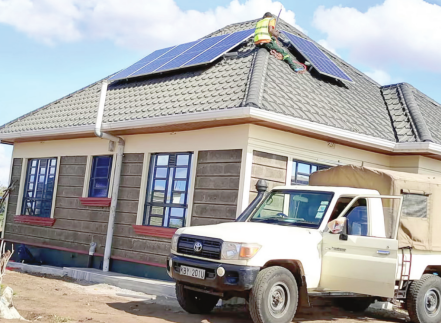How technology is reshaping the future of Kenya’s housing industry

The rising cost of commodities has seen Kenya’s housing sector tap into eco-friendly technologies in construction and development of units to cut cost, while taking care of environmental concerns.
With growing concerns over climate change, rising utility costs, and rapid urbanisation, the push for sustainable housing solutions has become more urgent than ever, experts say.
According to the 2023/24 Kenya Housing Survey, 82.5 per cent of Built Environment Professionals (BEPs) now recommend alternative building technologies (ABTs), signalling a collective movement toward reducing the environmental footprint of construction while addressing the growing housing demand.
These technologies, ranging from solar energy systems to stabilised soil blocks, are redefining the country’s approach to housing development.
Solar energy systems have emerged as the most preferred eco-friendly technology, with 34.8 per cent of BEPs advocating for their use. These systems, particularly effective in urban areas, are helping homeowners and developers offset rising electricity costs.
The survey highlighted their widespread appeal noting, “Solar systems offer a direct reduction in utility bills and provide reliable energy solutions.” Prefabricated panels, which reduce construction timelines and waste, were the second-most recommended at 15.7 per cent, while stabilized soil blocks, praised for their affordability and resource efficiency, came third at 11.2 per cent.
However, adoption remains limited for other technologies like biogas systems and rainwater harvesting, with less than 5 per cent uptake among professionals.
The shift toward eco-friendly housing is also tied to broader goals of sustainability and climate resilience.
With 37 per cent of professionals recommending ABTs for their environmental benefits, the sector is aligning with Kenya’s commitments to the Paris Agreement and the Sustainable Development Goals, particularly SDG 11, which focuses on sustainable cities and communities.
Stabilised soil blocks and recycled plastic materials are key in addressing deforestation and waste management challenges, while solar technology reduces reliance on non-renewable energy sources.
Despite its potential, the adoption of these technologies faces notable challenges. The high upfront costs of materials and systems remain a significant barrier, particularly for individual homeowners and small-scale developers.
Additionally, there is widespread skepticism about the durability and effectiveness of some alternative building materials. Many contractors report that clients still prefer conventional materials, even when presented with data on the cost savings and environmental benefits of ABTs.
“It’s hard to convince clients to embrace new technologies when traditional options are what they’ve always trusted,” said Wycliffe Okello, a contractor from Nairobi.
This resistance highlights the need for targeted efforts to educate the public and build capacity within the industry. The survey points to potential solutions, such as government subsidies for green materials and tax incentives for developers using ABTs. Urbanisation is accelerating the urgency of this transition. With cities like Nairobi and Mombasa grappling with rapid population growth, the demand for affordable and sustainable housing solutions has never been higher.
ABTs offer a way to meet this demand without compromising the environment or driving up long-term costs for homeowners.
The report emphasises that technologies like solar energy systems and prefabricated panels not only reduce construction timelines but also create resilient housing capable of withstanding climate shocks.















